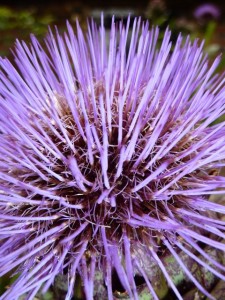
August is a time for frazzled lawns, thistledown parachutes and gaps in the flower-beds. In the East of England, drought usually kicks in. Here is a handy list of how to combat that drat drought weather. As ever, the way is to work with nature.
- Get your soil right. This winter incorporate humus rich material - this will improve both sands and open up clays that crack with lack of rain.
- Right plant, right place. Be rigorous and avoid any plant that wants cool, moisture retentive soils. A good choice will be silver leaved plants; they come from Meditteranean. So lavenders, sages, rosemaries all aromatic and will go thirsty
- Bare earth dries out and provides a seed bed for weeds. Weeds will compete for water and nutrients. Zero tolerance for weeds, therefore.
- Mulch your flowerbeds. This will discourage weed seeds from germinating . Moisture will be conserved too. Leafmould, spent mushroom compost, gravel, woodchip or shards of slate. All these can be used as mulches.
- 5. Cut back perennials in mid summer - a good treatment for catmints, hardy geraniums, and delphiniums for starters. This will bring on a second flush of leaves and flowers right through to the first frosts.
- Water wisely - give plants a good soak once a week rather than little and often. The aim is to encourage deep roots rather than shallow thirsty ones.
- Time of the day to water - early morning is the best. Avoid watering in bright sunshine.
- Keep plants healthy. Look out for early arrival of aphids and cut off and burn infested stems and buds.
- To solve the problem of bare gaps in a newly planted bed, sprinkle in the seeds of annuals to give colour and cover while the perennials and shrubs get going
- Top Ten Drought Plants of the Day:
- Perovskia atriplicifolia, called Russian sage - white bleached stems with intense blue flowers at the autumn end of summer
- Allium sphaerocephalon egg sized flowers, blood red in July, co-planted with the perovskia for a fantastic combination
- Echinops ritro. Metallic blue balls on tall stems. Beware prolifiic seeding though.
- Crocosmia Lucifer - has searing red exotic blooms that look like humming birds in action. companion plant with echnops. A 1980s combo.
- Erigeron karvinskianus - daisy to grow out of steps, gaps in paving - will seed everywhere. A low crawly filler.
- Iris germanica - these are bearded irises - practically every colour under the sun is available. go to www.woottensplants for a large selection.
- Astelia chatamica architectral silver leaves, this is what a phormium would look like if only it knew how. Looks great in a pot or as an eye catcher in a flower bed.
- Cynara cardunculus - artichoke - where space permits this will give a architectural effect and you can eat it.
- Digitalis purpurea- common old foxgloves but so easy to grow and in shade especially - a lovely plant. Pink but white is available too.
- Verbascum spp - foxglove effect, but more refined. There are lots of different new cultivars so plenty of colours to choose from.
 August is a time for frazzled lawns, thistledown parachutes and gaps in the flower-beds. In the East of England, drought usually kicks in. Here is a handy list of how to combat that drat drought weather. As ever, the way is to work with nature.
August is a time for frazzled lawns, thistledown parachutes and gaps in the flower-beds. In the East of England, drought usually kicks in. Here is a handy list of how to combat that drat drought weather. As ever, the way is to work with nature.
